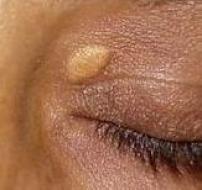Removal of xanthelasma palpebrarum

Clinical signs
The xanthelasma palpebrarum is a usually symmetrically appearing velvety surface yellow plane plaque on the lower or the upper eyelid. It usually develops in woman after 40 years. Histologically they are the deposition of cholesterol in the upper part of the dermis. It is the sign of the disturbed cholesterol metabolism but can develop with normal blood cholesterol level too. It is necessary to make blood cholesterol level if it is unknown. In the case of elevated cholesterol level it is necessary to treat it to decrease of the possibility of reappearance.
Therapy
The only reason for the treatment is esthetic so it needs your decision. The xanthelasma palpebrarum can be removed by carbon dioxide laser or by scalpel.
We make the removal of xanthelasma palpebrarum with carbon dioxide laser vaporization
I wait you with my 30 years experience
The mode of action of carbon dioxide laser in the removal of xanthelasma palpebrarum
The light of the carbon dioxide laser is absorbed in water that is found in every human tissue. During the absorption heat evolves, the cells boil and explode. In the case of xanthelasma palpebrarum the carbon dioxide laser evaporates the skin up to the level of the cholesterol deposition.
The carbon dioxide laser vaporization has several advantages in the removal of xanthelasma palpebrarum for the patient and the physician too
- It is absorbed in 0,1 mm depth in the skin so its effect can be controlled with great accuracy.
- There is no need to make suture.
- The operation is quick so the burden for you is minimal.
- The laser light obstructs the small blood vessels so there is no bleeding during the operation.
- You can very rarely feel pain after the operation.
- The laser light destroys the pathogens on the surface of the skin so the wound surface will be sterile.
- The wound heals quickly and with cosmetically good results.
- You have to use only a cream at home based on the written paper about it.
How is made the removal of xanthelasma palpebrarum by carbon dioxide laser?
The operation can be done with local anesthesia using lidocain injection. The time of the operation is between 10-20 minutes depending on the number and the size of the xanthelasma palpebrarum.
You have to do the followings after the carbon dioxide laser removal of xanthelasma palpebrarum
After the operation there will be serous discharge. The healing time is usually between 10 and 12 days depending on the size of the xanthelasma palpebrarum. Sunscreen using with at least 30 SPF for at least 3 months to prevent the brown discoloration is mandatory. You have to keep off from direct sunbathing and especially solarium use for at least 3 months.
The followings happen after the removal of xanthelasma palpebrarum by carbon dioxide laser
The pink color after the healing is part of the normal healing. It indicates that the healing has completed and it usually resolves in 4 weeks spontaneously. The removal of xanthelasma palpebrarum by carbon dioxide laser vaporization is a safe process but you have to follow the written and oral advices to prevent the side effects. The side effects are rare and they are the followings: bleeding, pain, inflammation around the wound.
In some cases the removal of xanthelasma palpebrarum by carbon dioxide laser is contraindicated
Unreal patient expectations, untreated diabetes.
Visit: 33 000 HUF
Operation: the first lesion: 52 000 HUF, the 2. lesion: 30 000 HUF, above 3 lesions: custom price

